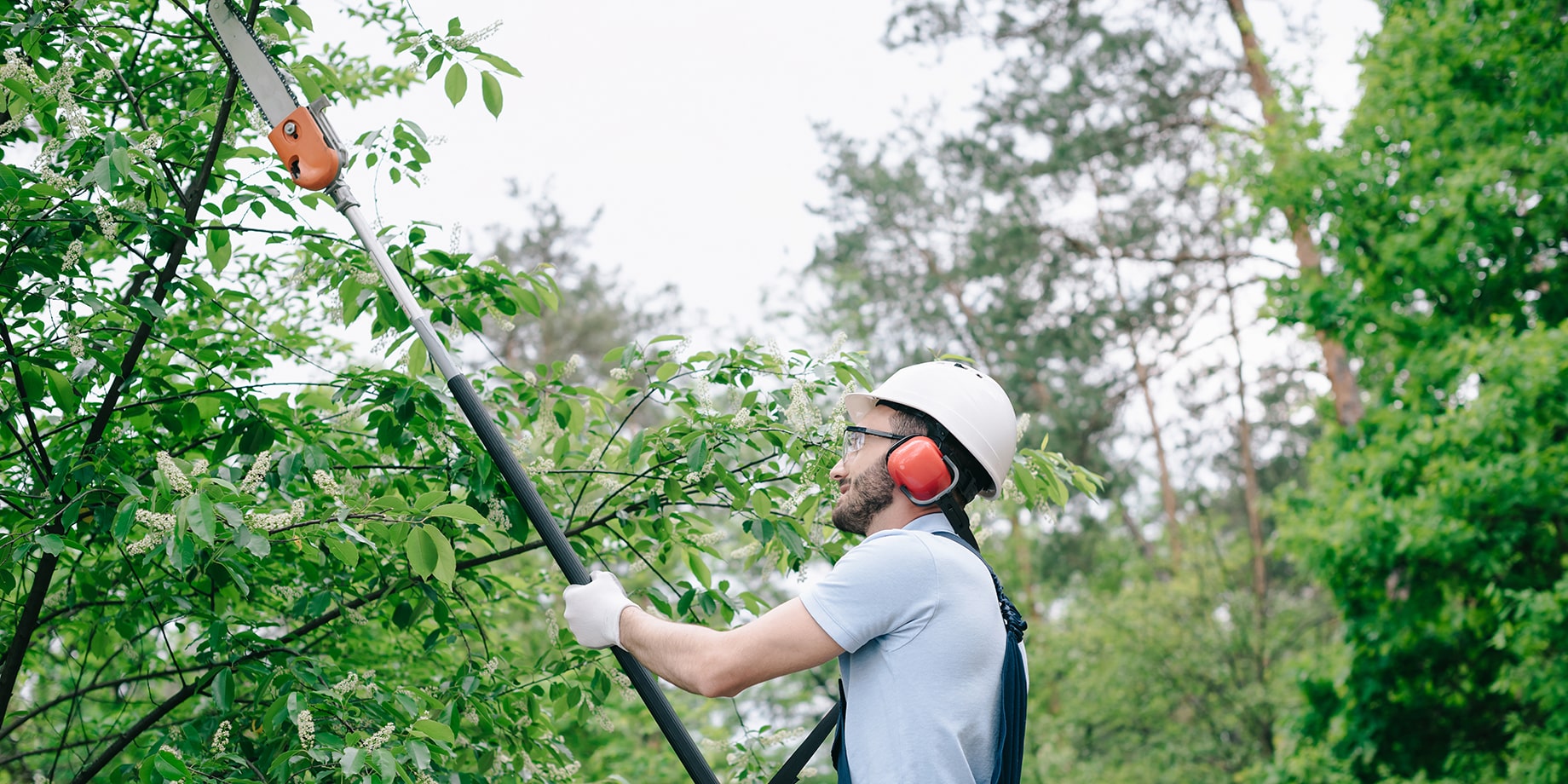Homeowner’s Insurance and Trees: What’s Covered?
When discussing homeowner’s insurance policies, most people think about their homes, personal belongings, or liabilities like accidents or natural disasters. But what about the trees in your yard? Trees, often cherished parts of landscaping, can be expensive to replace and might pose hazards in the event of a storm or other incidents. Whether you’re wondering if your trees are covered by insurance or concerned about potential risks involving trees on your property, understanding how insurance policies treat trees is essential.
Most standard homeowners’ insurance policies provide coverage for trees, but under specific conditions. Let’s explore some of the common scenarios where trees are included in insurance coverage.
Damage to Your Tree Due to Covered Perils
Homeowner’s insurance policies typically cover trees if they are damaged or destroyed by a covered peril. Some of the common perils include:
- Fire
- Lightning
- Explosion
- Vandalism
- Aircraft damage
- Riot or civil commotion
If a tree is damaged or destroyed due to any of these reasons, your homeowner’s insurance policy will typically cover the cost of removal and potentially a portion of the replacement costs. However, policies usually have limits on how much they’ll pay for tree removal or replacement, often capping coverage at $500 to $1,000 per tree.
Fallen Trees and Property Damage
If a tree falls and damages your house, garage, fence, or other structures due to a covered peril, your homeowner’s policy will generally cover the cost to remove the tree and repair the damage. For instance, if a tree crashes into your roof during a windstorm, the policy will cover both tree removal and roof repairs.
It’s essential to know that not all causes of fallen trees are covered. Insurance companies often don’t cover tree damage caused by:
- Neglect
- Diseased or dead trees
- Normal wear and tear
- Flooding (unless you have flood insurance)
In these cases, you’ll likely have to cover the costs of tree removal and any subsequent damages out-of-pocket.
Tree Removal Coverage
Many homeowners assume that their insurance will always cover tree removal, but that isn’t always true. Your insurance policy will generally cover the cost to remove a tree if it has fallen due to a covered peril and caused damage to a structure on your property. If a tree falls and doesn’t damage anything, such as when it falls in an empty yard or garden, insurance might not cover the removal.
Typically, insurance policies limit the amount they’ll pay for tree removal to around $500 to $1,000, though this varies by provider and specific policy.
Tree Removal After a Natural Disaster
In regions prone to hurricanes, tornadoes, or other natural disasters, tree damage is common. While wind and storms are usually covered perils, flooding generally isn’t unless you’ve purchased separate flood insurance.
If a tree falls on your property due to a natural disaster and damages a structure, your homeowner’s policy will likely cover the removal of the tree and repairs. However, the same tree falling on an open yard, driveway, or garden might not be covered, as no insured structure was harmed.
Liability for Neighbor’s Trees
When a tree on your property falls and damages a neighbor’s home, the responsibility often depends on the health of the tree before the incident. If the tree was healthy and the fall was caused by an act of nature (like a storm), your homeowner’s insurance usually won’t be held responsible for damage to the neighbor’s property. Instead, your neighbor’s homeowner’s insurance should cover the damages.
However, if your tree was dead, diseased, or previously neglected, you could be held liable, and your insurance may be called upon to cover your neighbor’s damages.
What’s Not Covered?
While many situations involving trees are covered, there are exclusions to be aware of:
- Flooding: Tree damage from flooding isn’t covered unless you have flood insurance.
- Earthquakes: Standard homeowner’s insurance doesn’t cover earthquakes or tree damage caused by seismic activity. Separate earthquake insurance is required.
- Diseased or Neglected Trees: If a tree is dead, diseased, or shows signs of neglect, any damages or removal costs are typically not covered by homeowner’s insurance.
- Intentional Acts: If you intentionally cause damage to your tree, the insurance company will deny your claim.
Here’s a table listing some states where tree removal is typically covered under homeowner’s insurance policies. Please note that the coverage is dependent on the insurance provider and policy terms rather than specific state laws. However, the table below gives an overview of how tree removal coverage is commonly applied in different states, including factors like common covered perils and specific state risks that may affect coverage.
What is not covered by homeowners insurance when a tree falls?
When a tree falls, homeowners insurance typically provides coverage under specific circumstances, but there are certain scenarios where a claim may be denied. Understanding what is not covered by homeowners insurance in the event of a fallen tree is important for protecting yourself from unexpected expenses. Here’s a detailed breakdown of what is generally not covered by homeowners insurance when a tree falls:
1. No Damage to Insured Structures
One of the most common reasons for a claim denial is when a tree falls but does not cause damage to any insured structures on your property. Most homeowners insurance policies only cover tree removal and related expenses if the fallen tree damages a covered structure, such as:
- The house
- Garage
- Shed
- Fence
- Deck
If the tree falls in an open space, like a yard or driveway, and doesn’t cause any structural damage, your insurance will likely not cover the cost of tree removal. In such cases, the responsibility for tree removal typically falls to the homeowner.
2. Normal Wear and Tear, Age, or Neglect
Homeowners insurance does not cover damage caused by trees that fall due to neglect, age, or disease. If a tree is already dead or dying due to lack of maintenance, poor health, or natural aging, the insurance company may determine that you are responsible for its condition. In these cases:
- If the tree falls and causes damage, the cost to repair the damage may not be covered.
- Insurance may also deny coverage for tree removal if the tree’s fall is due to neglect or poor maintenance.
To avoid this, it’s important to regularly inspect your trees and take proactive steps to remove dead or diseased ones.
3. Flooding or Water Damage
Standard homeowners insurance does not cover damage caused by flooding. If a tree falls due to floodwaters or if a tree is uprooted and damages your property because of flooding, your homeowner’s policy will not cover the removal or related damage costs. Flood-related damages, including tree damage, are only covered if you have purchased separate flood insurance through the National Flood Insurance Program (NFIP) or another provider.
4. Earthquake or Land Movement
Homeowners insurance does not cover damages caused by earthquakes or land movement unless you have purchased an additional earthquake policy. If a tree falls due to seismic activity or related ground movement (like a landslide or sinkhole), the damage is not covered under standard policies. Separate earthquake or ground movement insurance is required for these types of events.
5. Damage to Non-Insured Structures
If the tree falls on a structure that is not covered by your insurance policy, such as certain outbuildings, sheds, or older structures that you’ve opted not to insure, the damage won’t be covered. Insurance will only pay for repairs or removal costs related to insured structures. It’s important to make sure all the structures on your property that are valuable to you are included in your insurance policy.
6. Intentional Damage
If the tree falls due to intentional acts of damage, such as cutting it down improperly or causing it to fall, this is considered intentional damage, and your insurance policy will not cover it. Homeowners insurance is designed to cover accidental and natural causes of damage. Therefore, self-inflicted damage or reckless handling of trees will result in claim denial.
7. Removal Costs Beyond Coverage Limits
Even when a tree fall and removal are covered by insurance, the amount that an insurance company will pay for tree removal is usually subject to coverage limits. For example:
- Policies often have a per-tree removal limit, typically ranging from $500 to $1,000.
- Many policies also have an aggregate limit on total tree removal, such as $5,000.
If your costs for tree removal exceed these limits, you will be responsible for the difference. Additionally, insurance typically does not cover the full replacement cost of a tree if it is destroyed—this is usually limited to a small sum, if covered at all.
8. Trees Falling Due to Lack of Proper Care
If a tree falls due to a known condition, such as visible signs of rotting, poor health, or previous warnings from arborists, your insurer may determine that the fall was preventable. In these situations, if the tree causes damage, your claim could be denied due to the lack of preventive action taken to maintain the tree’s health.
9. Business-Related Damage
If a tree falls and causes damage related to a home-based business or business equipment, homeowners insurance will not cover the loss. Homeowners policies generally exclude business-related liabilities or property, so a fallen tree damaging business assets will require commercial insurance to cover the loss. If you run a business from your home, you may need a business property endorsement to ensure your equipment and assets are protected.
10. Tree Debris Removal in Public Spaces
If a tree on your property falls and lands in a public space, such as a road, sidewalk, or neighbor’s yard, homeowners insurance typically won’t cover the removal of the tree from those areas. Local municipalities or the affected property owner may handle the removal, depending on the jurisdiction. However, if the tree damages public property, such as power lines or streets, you could be held liable for the cleanup costs unless the tree fell due to a natural event.
Summary of What’s Not Covered:
- Fallen trees that don’t damage insured structures
- Tree damage caused by neglect, disease, or lack of maintenance
- Flood or earthquake-related tree damage
- Intentional acts leading to tree fall
- Tree removal costs exceeding policy limits
- Damage to uninsured structures or home-based business equipment
How to Avoid Coverage Issues
To avoid potential claim denials, it’s essential to:
- Regularly maintain your trees by trimming and removing dead or diseased trees.
- Check your policy to ensure that all your structures are covered and understand the specific limits for tree removal.
- Consider purchasing additional flood or earthquake insurance if you live in an area prone to these perils.
- Work with professionals when dealing with potentially dangerous trees to ensure proper removal and avoid intentional damage claims.
By understanding the limitations of your homeowner’s insurance, you can take proactive steps to ensure you’re covered when a tree falls and avoid any surprises during the claims process.
| State | Common Perils Covered for Tree Removal | State-Specific Risks | Additional Considerations |
|---|---|---|---|
| California | Fire, windstorm, lightning, vandalism, explosion | Wildfires, earthquakes, windstorms | Earthquake coverage typically requires a separate policy |
| Florida | Windstorm, fire, lightning, vandalism | Hurricanes, tropical storms, high winds | Hurricane-specific deductibles apply; flood insurance needed |
| Texas | Fire, windstorm, hail, lightning | Tornadoes, hailstorms, wildfires | Insurance may limit coverage for storm-related tree removal |
| New York | Windstorm, fire, vandalism, lightning | Winter storms, heavy snow, nor’easters | Ice damage or snow load may affect tree-related claims |
| North Carolina | Windstorm, fire, lightning, vandalism | Hurricanes, tropical storms | Tree removal is generally covered if it damages an insured structure |
| Colorado | Fire, windstorm, hail, explosion | Wildfires, hailstorms, windstorms | High altitude risks from windstorms and snow coverage is key |
| Illinois | Windstorm, fire, hail, lightning | Tornadoes, severe thunderstorms | Policies often cover tree removal if it damages home or structures |
| Georgia | Windstorm, fire, hail, lightning | Tornadoes, hurricanes, heavy storms | Tree removal coverage applies if property is damaged |
| Pennsylvania | Windstorm, fire, lightning, vandalism | Ice storms, windstorms, thunderstorms | Snow or ice-related tree damages may be covered with conditions |
| Washington | Windstorm, fire, explosion, lightning | Windstorms, wildfires, heavy rainfall | Insurance policies may limit the coverage for non-damaging fallen trees |
Explanation of Key Factors:
- Common Perils Covered: Most homeowner’s insurance policies include perils such as windstorms, fire, and lightning as the main reasons for tree damage. Tree removal coverage is generally triggered when trees are affected by these covered perils and cause damage to insured structures like homes or garages.
- State-Specific Risks: Certain states have unique weather risks that may affect tree removal coverage. For example, states like Florida and North Carolina frequently experience hurricanes, which can lead to significant tree damage. Wildfire-prone states like California and Colorado have their own specific insurance considerations for trees.
- Additional Considerations: Coverage for tree removal may be limited depending on whether the tree caused damage to insured structures. In most cases, if the tree falls and does not damage any property, homeowners might not be able to claim tree removal expenses. State-specific risks, such as hurricanes or wildfires, may also lead to higher deductibles or additional policy endorsements.
This table provides a general overview; it’s crucial for homeowners to review their specific insurance policy or consult with their provider to understand tree removal coverage limits in their state.
How Much Will Insurance Pay for Tree Damage?
Insurance companies often have limits on how much they’ll pay for tree removal and replacement. Many policies set limits between $500 and $1,000 per tree. Some policies also have an aggregate limit, meaning they won’t pay more than a set amount for multiple trees.
For example, if you lose five trees in a storm, and your policy has a $1,000 limit per tree with a $5,000 aggregate limit, your policy will only pay up to $5,000 total, even if removing the trees costs more than that.
Additionally, insurance policies generally don’t pay the full cost to replace a tree. Some might only cover part of the replacement cost or offer a small lump sum.
How to File a Tree Damage Claim
If a tree on your property is damaged, follow these steps to file a claim with your insurance company:
- Document the Damage: Take pictures of the fallen or damaged tree, and if the tree caused damage to any structures, make sure to photograph those as well.
- Report the Claim: Contact your insurance company as soon as possible to report the damage. Provide them with the documentation and information they need to process the claim.
- Get an Estimate: Depending on the extent of the damage, your insurance company may send an adjuster to assess the damage or request you to obtain an estimate for the repairs.
- Review the Policy: Make sure you understand your policy’s limits and exclusions before moving forward with repairs or tree removal.
- Complete Repairs and Removal: Once your claim is approved, you can move forward with the repairs and tree removal. Keep all receipts and documentation for reimbursement.
Top Insurance Companies for Tree Coverage
Here’s a list of top 10 homeowners insurance companies in the U.S. that provide coverage for trees as part of their standard policies. These companies are highly rated for their customer service, financial stability, and comprehensive coverage options, including provisions for tree damage and removal.
| Company Name | Average Annual Premium | Tree Coverage Details | Policy Limit per Tree | Aggregate Limit | Financial Strength (AM Best) |
|---|---|---|---|---|---|
| State Farm | $1,500 | Covers tree damage from fire, lightning, and storms | $500 per tree | $5,000 aggregate | A++ |
| Allstate | $1,400 | Offers coverage for fallen trees from covered perils | $500 per tree | $10,000 aggregate | A+ |
| Liberty Mutual | $1,600 | Covers tree removal if it damages a structure | $1,000 per tree | $5,000 aggregate | A |
| USAA | $1,300 | Tree removal covered for structural damage | $1,000 per tree | No specific limit | A++ |
| Farmers Insurance | $1,450 | Covers fallen tree removal if property damage occurs | $750 per tree | $5,000 aggregate | A |
| Travelers | $1,550 | Tree removal coverage for damaged structures | $1,000 per tree | $10,000 aggregate | A++ |
| Nationwide | $1,500 | Tree damage from windstorms, fires, and vandalism | $500 per tree | $5,000 aggregate | A+ |
| Progressive | $1,550 | Covers trees damaged by fire, storms, and vandalism | $500 per tree | $5,000 aggregate | A+ |
| American Family | $1,400 | Provides coverage for tree removal after damage | $500 per tree | $5,000 aggregate | A |
| Chubb | $1,700 | High coverage limits for tree damage | $1,500 per tree | $15,000 aggregate | A++ |
frequently asked questions (FAQs) related to tree coverage in homeowner’s insurance:
1. Are trees automatically covered under my homeowner’s insurance policy?
Yes, trees are usually covered under most standard homeowner’s insurance policies, but only under specific conditions, such as damage caused by covered perils like fire, lightning, or windstorms. However, insurance may not cover tree removal if no insured structure is damaged.
2. Will my insurance cover the removal of a fallen tree that didn’t damage any structures?
Most insurance policies won’t cover the cost of tree removal unless the tree damages an insured structure, such as your house, garage, or fence. If the tree falls without causing any damage, such as landing in an open yard or driveway, you may have to pay for removal yourself.
3. If my tree falls on my neighbor’s property, who is responsible for the damages?
If the tree was healthy and fell due to natural causes (like a storm), your neighbor’s homeowner’s insurance would typically cover their damages. However, if the tree was dead, diseased, or neglected, you could be held liable, and your insurance may need to cover the costs.
4. Does homeowner’s insurance cover tree removal after a hurricane or tornado?
Homeowner’s insurance usually covers tree removal if the tree falls due to a covered peril (like wind or a storm) and damages an insured structure. However, if the tree falls without causing structural damage, the cost of removal may not be covered.
5. What is the typical coverage limit for tree removal in a homeowner’s policy?
Most homeowner’s insurance policies have limits for tree removal, typically ranging from $500 to $1,000 per tree. Some policies also have an aggregate limit, such as $5,000, which applies to multiple trees.
6. Are tree-related damages caused by flooding covered by homeowner’s insurance?
No, standard homeowner’s insurance policies do not cover damages caused by flooding. If tree damage occurs due to flooding, you would need separate flood insurance to cover the costs.
7. Does homeowner’s insurance cover the replacement of a damaged tree?
In some cases, homeowner’s insurance may cover part of the replacement cost of a tree if it was damaged or destroyed by a covered peril. However, the coverage limit is usually small, often capped at around $500 to $1,000 per tree.
8. What happens if a dead or diseased tree on my property falls and causes damage?
If a dead or diseased tree falls and causes damage, insurance might deny your claim, citing neglect. Homeowners are responsible for maintaining healthy trees. If the tree’s condition was the result of neglect, you could be liable for any damages caused.
9. Does homeowner’s insurance cover damage caused by trees during an earthquake?
No, standard homeowner’s insurance does not cover earthquake-related damages, including tree damage. You would need to purchase separate earthquake insurance to protect against damages from seismic events.
10. What should I do if a tree on my property is damaged during a storm?
If a tree is damaged during a storm, document the damage with photos, report the claim to your insurance company as soon as possible, and check your policy to understand coverage limits. If the tree causes structural damage, your insurance may cover tree removal and repairs.
These FAQs help clarify common concerns about how trees are handled under homeowner’s insurance policies and what homeowners should be aware of regarding tree damage and removal coverage.




